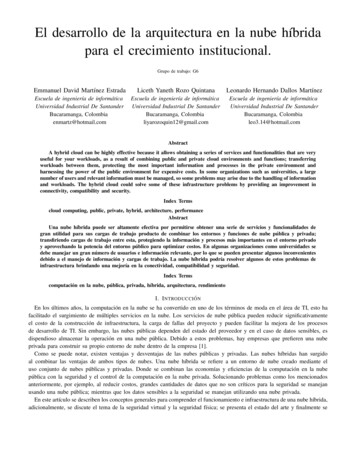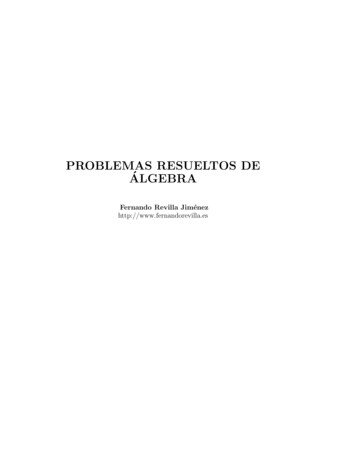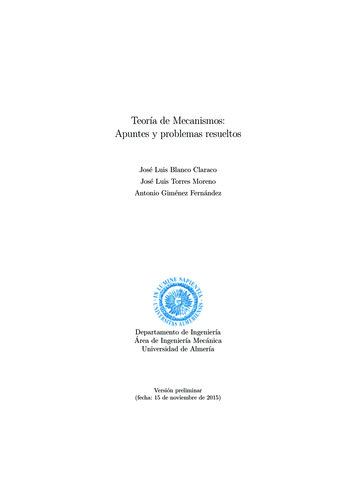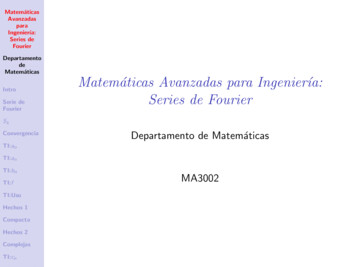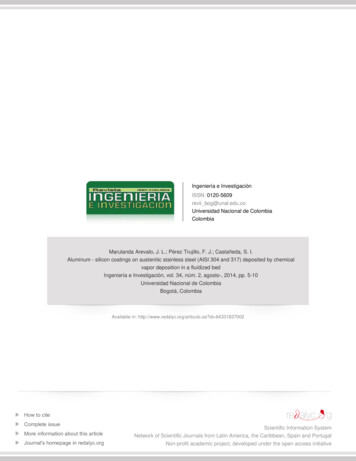
Transcription
Ingeniería e InvestigaciónISSN: 0120-5609revii bog@unal.edu.coUniversidad Nacional de ColombiaColombiaMarulanda Arevalo, J. L.; Pérez Trujillo, F. J.; Castañeda, S. I.Aluminum - silicon coatings on austenitic stainless steel (AISI 304 and 317) deposited by chemicalvapor deposition in a fluidized bedIngeniería e Investigación, vol. 34, núm. 2, agosto-, 2014, pp. 5-10Universidad Nacional de ColombiaBogotá, ColombiaAvailable in: http://www.redalyc.org/articulo.oa?id 64331837002How to citeComplete issueMore information about this articleJournal's homepage in redalyc.orgScientific Information SystemNetwork of Scientific Journals from Latin America, the Caribbean, Spain and PortugalNon-profit academic project, developed under the open access initiative
INGENIERÍA E INVESTIGACIÓN VOL. 34 No. 2, AUGUST - 2014 (5-10)Aluminum-silicon coatings on austenitic stainless steel(AISI 304 and 317) deposited by chemical vapor depositionin a fluidized bedRecubrimientos de aluminio-silicio sobre acero inoxidable austeníticoAISI 304 Y 317 por deposición química de vapor en lecho fluidizadoJ. L. Marulanda Arevalo1, F. J. Pérez Trujillo2 and S. I. Castañeda3ABSTRACTAluminum-silicon coatings were deposited onto stainless steels AISI 304 and AISI 317. The deposition was performed at 540 C with aratio of active gases HCl/H2 of 1/15.3; argon was used as a carrier gas. The bed of the FBR-CVD process consisted of 2.5 g aluminumpowder, 7.5 g silicon powder and 90 g alumina. After the coatings were deposited, each sample was given a heat treatment toimprove its mechanical properties and oxidation behavior by diffusing the alloying elements. Thermodynamic simulation was performed with Thermo-Calc software to investigate the composition of the deposited material. The coated and uncoated specimenswere exposed to temperatures of 750 ºC in an atmosphere where the vapor was transported to the samples using a flow of N2 of 40ml/min and 100% water vapor (H2O). The coated specimens gained little weight during the thousand hours of exposure and will thusguard against a corrosive attack compared to the uncoated substrates. In addition, the coated stainless steels show an oxidation ratewith a logarithmic trend while the uncoated steel oxidation rate showed a linear trend.Keywords: Coating, aluminum-silicon, chemical vapor deposition, high temperature oxidation, stainless steel, oxidation rate, steamoxidation.RESUMENSe obtuvieron recubrimientos de aluminio-silicio en los aceros inoxidables AISI 304 y AISI 317. La deposición se realizó a 540 C, con unaproporción de gases activos (HCl/H2: 1/15.3), como gas de arrastre se utilizó argón. El lecho del proceso CVD-FBR estaba formado por2,5 g de polvo de aluminio, 7,5 g polvo de silicio y 90 g de alúmina. Después de depositados los recubrimientos, se le dio un tratamientotérmico para mejorar sus propiedades mecánicas y su comportamiento frente a la oxidación, por entre la difusión de los elementosde aleación. La simulación termodinámica se realizó con el software Thermo-Calc para obtener información sobre la posible composición del material depositado. Las muestras recubiertas y sin recubrir, se expusieron a 750 ºC en una atmósfera donde el vapor setransporta a las muestras usando un flujo de N2 de 40 ml / min y 100% de vapor de agua (H2O). Aceros recubiertos ganaron algo depeso durante las mil horas de exposición y resisten muy bien el ataque corrosivo frente a los sustratos recubiertos. Además, los acerosinoxidables recubiertos muestran una velocidad de oxidación con tendencia logarítmica, mientras que la velocidad de oxidaciónde acero sin recubrimiento tiene tendencia lineal.Palabras clave: Recubrimiento, Aluminio/Silicio, Deposición Química de Vapor, Oxidación a Alta temperatura, acero inoxidable,velocidad de oxidación, oxidación en vapor.Received: December 17th 2013Accepted: May 5th 2014Introduction12 3The need to protect surface components that operate at high temperatures has increased significantly. Coatings are an effectivemethod to improve the surface properties of materials. Additionally, reactive metals in the coatings diffuse into the substrate to aconsiderable depth; essentially, diffusion layers work as the alloyJose Luddey Marulanda Arevalo. Doctor en Química Avanzada, Universidad Complutense de Madrid, Spain. Affiliation: Profesor asociado, Universidad Tecnológica dePereira (UTP), Colombia. E-Mail: jlmarulanda@utp.edu.co2 Francisco Javier Pérez Trujillo. Doctor, Universidad Complutense de Madrid(UCM), Spain. Affiliation: Profesor, Universidad Complutense de Madrid (UCM).Grupo de investigación en Ingeniera de Superficies y Materiales Nano estructurados,Spain. E-Mail: fjperez@quim.ucm.es.1surface with a gradient of composition with a small amount of anexpensive super alloy on the surface (Christoglou, Voudoris, &Angelopoulos, 2002; Anastassiou, Christoglou, & Angelopoulos,2010; Hao-Tung, Sheng-Chang, Jow-Lay, & Shin-Yun, 2007). Increasing the temperature capabilities of a material for advancedpower generation applications is of great importance due to theSaul Isaac Castañeda. Doctor, Universidad Complutense de Madrid (UCM). Affiliation: Investigador, Universidad Complutense de Madrid (UCM). Grupo de investigación en Ingeniera de Superficies y Materiales Nano estructurados, Spain.E-Mail: sicastan@quim.ucm.es.3How to cite: Marulanda, J. L., Pérez, F. J., & Castañeda, S. I. (2014). Aluminumsilicon coatings on austenitic stainless steel (AISI 304 and 317) deposited by chemicalvapor deposition in a fluidized bed. Ingeniería e Investigación, 34(2), 5-10.5
ALUMINUM-SILICON COATINGS ON AUSTENITIC STAINLESS STEEL (AISI 304 AND 317) DEPOSITED BY potential gain in energy efficiency and the decrease in pollutantemissions (Perez et al., 2006a). Chemical vapor deposition is a versatile process that allows the application of different metal and ceramic materials for the protection of materials against wear, corrosion and oxidation at high temperatures in the aircraft industry,military and engineering in general. The process of chemical vapordeposition is a dynamic and complex system, where the thermodynamics, kinetics and transport phenomena are essential stepsthat utilize the chemical reactions of precursor gases to form asolid and stable product (Choy, 2003; Abella, 2003; Brossard, Hierro, Sanchez, Bolivar, & Pérez, 2006). Chemical vapor depositionin a fluidized bed (CVD-FBR) is a variant of the chemical vapordeposition process. The CVD-FBR combines the advantages ofthermal activation by heating and the fluidized bed, which providesthe high mass and thermal transfer between the gas, the bed andthe samples inside the reactor. The samples were placed abovethe fluidized bed, which produced a more uniform temperatureand good mixing of the reactive gases with the fluidized particles,achieving a high degree of reaction of all species activated in thebed. As a result, there is excellent contact between the solid particles and the fluidization gas (Perez, Pedraza, Hierro, & Hou, 2000;Zhan, He, Wang, & Gao, 2006; D. Chaliampalias, Vourlias, Pistofidis, Pavlidou, & Stergiou, 2007). The main disadvantage ofCVD-FBR is the need for a well-designed gas distributor, which isinevitably associated with the gradual deposition of solids and thegeneration of agglomerates due to the frequency of relative motion. The proper design of the reactor geometry ensures efficientcontact between the gas and solid, as well as uniformity in themovement of the solid, which is very important for obtaining quality coatings (Perez et al., 2006a; Tsipas, Anthimides, & Flitris, 2003;Golman, & Shinohara, 1999; Kim, & Young; 2006).The determination of the process conditions (i.e., temperature,reactant concentration and gas flow rate) is always a critical stepin the deposition of coatings. In all cases, a thermodynamic studyof the phase equilibrium (i.e., composition and partial pressure)during the CVD process is necessary to determine the feasibilityof the metal deposition and provides a useful guideline to improvethe deposition condition (Brossard, Hierro, Sanchez, Bolivar, &Pérez, 2006).The use of aluminum layers is an effective way to increase the corrosion resistance of steels. This protection is obtained by forminga surface film of Al2O3. The coating grows by internal diffusion ofthe aluminum, as the iron and chromium diffuse outward (Christoglou, Voudouris, Angelopoulos, Pant, & Danhl, 2004). The inherent property of aluminum to form stable layers of Al2O3 in atmospheres containing oxygen is well known and has been adapted forthe surface enrichment of steel components that operate in aggressive environments at high temperature because alumina hasexcellent mechanical properties and good chemical stability at hightemperatures (Sanchez, Bolivar, Hierro, & Pérez, 2008).Experimental procedureSpecimens of the austenitic stainless steels AISI 304 and AISI 317with dimensions 20 mm x 6 mm x 2 mm were used. For this studyof aluminum-silicon co-deposition, the specimens were machinedand polished using emery paper No. 100 to No. 600 and thencleaned in an ultrasonic bath of ketones for 10 minutes. Thermodynamic simulations were performed to investigate the optimumconditions for the co-deposition of aluminum-silicon coatings withCVD-FBR using Thermo-Calc software (ThermoCalc Software,2003). The calculations are based on the free Gibbs energy minimization method and mass conversion rule. The thermodynamicsimulation was performed with Thermo-Calc software, combining6the SSOL2 and SSUB3 databases of the Scientific Group Thermodata Europe to define the gaseous species and solid species. Thesecalculations were performed to determine the effects of the mainCVD-FBR parameters (i.e., T, gas composition and powder mixture) on the equilibrium partial pressure of the generated Al–Siprecursors. The main gas precursors and phases formed at equilibrium in the temperature range of 460 - 640 C were investigatedand provide an understanding of the reactions occurring duringdeposition. The schematic diagram of the CVD-FBR system usedin this study is described elsewhere (Perez et al., 2006b). The reactor was made of a quartz tube and was heated by an externalfurnace. The bed used was composed of a mix of aluminum powder of 99.5 % of purity and 400 µm particle size, and silicon powder of 99.5 % of purity and 200 µm particle size as the donor; 90wt% alumina (Al2O3) was used as the inert bed. The powder mixture was fluidized by Ar gas (99.999 % purity), and hydrogen chloride plus hydrogen (HCl H2) was used as an activator to generate an aluminum and silicon precursor. Mass flow meters wereused for controlling the flow of H2, HCl and Ar. The chamber reaction temperature was controlled by a thermocouple in the fluidized bed, and the samples were suspended above the fluidizedbed for the aluminum-silicon co-deposition. The coatings were deposited at temperatures below 580 C by CVD-FBR, using the beddescribed. This bed was fluidized with Ar between 500 and 800ml/min, and a mixture of HCl/H2 at a ratio of 1/12 to 1/20 wasused as an activator. These tests were performed between 520and 580 C with exposure times of 45 minutes to 1.5 hours onthe different types of austenitic stainless steels. After depositionof the CVD-FBR coatings, a diffusion heat treatment was performed in an argon gas flow at 750 ºC for 2 h, followed by coolingin a furnace under an atmosphere of Ar gas. The morphology ofthe aluminum-silicon layers was carried out using metallographicpreparation followed by a scanning electron microscope (SEMJEOL JM-6400); the composition was studied by energy dispersedX-ray spectroscopy (EDAX), and its structure was studied by anX-ray diffractometer (XRD-PHILIPS X (PERT MPD)) through themodes θ-2θ at a grazing angle. The specimens were exposed to750 ºC in an atmosphere where the vapor was transported to thesamples by a flow of N2 at 4 ml/min with 100 % water vapor (H2O).The test was conducted for up to 1000 hours, taking samples at200, 400, 600, 800 and 1000 hours. After each exposure the samples were cooled inside the furnace and the samples were weighedon an analytical balance with a precision of 10-5 g.Results and discussionAluminum-Silicon coatingsThe results from the thermodynamic simulations were used as aguide to select the starting conditions of the FBCVD tests; information about the precursors and compounds that were formedcan be determined theoretically, including the partial pressures ofthe main gaseous halides. The main precursors found are in agreement with those found in the literature. The thermodynamic simulation is a good tool to understand that the precursors can beformed when argon, HCl and H2 are passed through a bed containing aluminum and silicon and to help select the proportions ofthese gases to produce a good coating. For the thermodynamicprediction of the gas precursors, the input conditions includedAl(s), Si(s) and Ar/HCl/H2 gas mixture; Al2O3 was excluded because it is inert in the temperature range studied. This simulationwas carried out between 460 and 640 ºC to investigate the mainprecursors formed, as shown in Figure 1a, where the precursorsof aluminum and silicon are formed as AlCl3, Al2Cl6, AlCl2H,ClH3Si, and AlCl and in smaller proportions as AlCl2 and AlClH2.INGENIERÍA E INVESTIGACIÓN VOL. 34 No. 2, AUGUST - 2014 (5-10)
MARULANDA, PÉREZ AND CASTAÑEDAThe AlCl3 was the aluminum precursor that was most prevalentbut was very stable; its contribution to the deposition of the aluminum layer was thus very low. The amount of Al2Cl6 decreaseswith increasing temperature and drops below the amount ofAlCl2H above 565 C. ClH3Si is the main precursor to depositsilicon in the coating and has a slight tendency to decrease withtemperature; above 570 C, its amount reduces below that ofAlCl. Halides react more readily and will have a greater contribution to the deposition of aluminum atoms; these include AlCl,AlClH2, AlCl2 and AlCl2H. The AlCl2H and AlCl species are mostimportant in the deposition of aluminum in the coating; these twospecies also have the highest partial pressures in the range of temperatures that were investigated. Therefore, the main species affecting deposition are ClH3Si for the silicon deposition and theAlCl2H and AlCl for the aluminum deposition. The amount ofClH3Si was slightly below that of AlCl2H and above that of AlClup to 570 ºC, which ensures a co-deposit of Al and Si below thistemperature; however, the Gibbs free energy was less negative forClH3Si than for AlCl2H and AlClH2480520560600640Temperature( C)TEMPERATUREa) Gaseous speciesSOLIDPHASES(MOLE)Solid Phases(Mole)FeSiGASBBC 100.050,05BBC A2Cr5Si3MoSi2Mo5Si3480520560600640Temperature( C)TEMPERATUREb) Solid speciesFigure 1. Thermodynamic simulation of aluminum-silicon co-deposition process on the austenitic stainless steels.The thermodynamic simulations were performed to obtain approximations of the quantity of the Al and Si compounds formedin the CVD-FBR reactor during the deposition process. The inputconditions included Al(s), Si(s), substrate and Ar/HCl/H2 gas mixture. The possible solid phases that could be encountered duringthe process of co-deposition of aluminum-silicon on the two austenitic stainless steels were also determined as a function of temperature. The simulation was carried out between 460 and 640ºC, as shown in Figure 1b), where there are solid phases of theco-deposition of the AISI 317 steels were FeSi, Al3Ni2, Cr5Si3,BBC A2, Mo5Si3 and MoSi2, where the compound BBC A2 isformed by Fe0.532Al0.263Mn0.193 Cr0.005 Si0.005. The solid-phase simulation for the AISI 304 steel specimen increased the amount ofAl2Fe because this steel had more iron, and the Mo5Si3 disappearedbecause the molybdenum content is very low compared to theAISI 317 steel. FeSi is the most stable compound throughout thetemperature range investigated, followed by Cr5Si and Al3Ni2. Thecompounds BBC A2 and Al2Fe are in small quantities; it is alsoshown that when BBC A2 increase, Al2Fe decreases. Analyzingdata from the simulation thermodynamics of the gas and solidphases, it is likely that silicon increased in the coating during theco-deposition of aluminum-silicon at temperatures below 580 C;540 C was selected as a possible test temperature for the co-deposition of aluminum-silicon to investigate the increase in theamount of silicon present in the coating.Pre-eliminate tests of the co-deposition were conducted in theCVD-FBR reactor using a bed formed by a 5% aluminum powder,5% silicon powder and 90% inert alumina bed. It was fluidized with61% argon and by a mixture of 37.1% hydrogen and 1.9% hydrochloric acid as a gas activator for a period of 90 minutes at 580 C;these values yielded the best deposition conditions for the aluminum coating. The above conditions yielded good coatings approximately 12 /- 4 µm thick, but the amount of silicon incorporatedinto the coating was less than 0.5%. Therefore, the ratio of siliconto aluminum was changed to 9 % silicon and 1 % aluminum; thisstill only produced aluminum coatings with minimal amounts ofsilicon. The ratios of the active gases HCl/H2 were then changedfrom 1/19 to 1/14; the amounts of aluminum and silicon in the bedwere also changed from 5 % to 1 % and from 5 % to 9 %, respectively, to achieve the incorporation of silicon at 580 C. This wasstill not successful: only aluminum coatings were obtained. The relationship of HCl/H2 was also reduced to 1/14 to produce chlorinecoatings; the deposition time was also changed to 45 minutes. Unfortunately, these modifications did not produce uniform coatingsor increased amounts of silicon in the materials. As the incorporation of silicon was lowest in the co-deposition aluminum-silicon,the deposition temperature was lowered to 540ºC because therewas more ClH3Si at this temperature, which provided a greaterpossibility of deposited silicon; also, the thermal activation wouldbe improved, likely producing a quality aluminum-silicon coating.It was shown that the coatings vary significantly based on the activegases, amounts of aluminum and silicon in the bed and the deposition time; these parameters greatly affect the co-deposition of aluminum-silicon. The best aluminum-silicon coatings were obtainedwhen the deposition was performed at 540 C with a ratio of activegases HCl/H2 of 1/15.3 with 2.5 g of aluminum powder and 7.5 gof silicon powder in the bed and a ratio of 45 % active gases to 55% neutral gases. The best deposits are reached in the early stagesof bed fluidization because the fluid bed has a low gas velocity atthis time. Aluminum-silicon co-deposition was achieved under theabove parameters; the temperature was then changed to 520 Cand 560 C because 580 C did not yield silicon in the coating. Theother parameters were kept constant to observe the influence oftemperature, but non-homogeneous layers were obtained. Thistemperature change was shown to affect the co-deposition of aluminum-silicon. For a new co-deposition, the amount of activegases and inert gases H2/HCl must be varied; therefore, the influence of temperature was not observable because it created a newdeposition with other conditions and most likely another composition. The coatings created at 540 ºC with an exposure time of60 minutes were chosen because they had the best characteristics.INGENIERÍA E INVESTIGACIÓN VOL. 34 No. 2, AUGUST - 2014 (5-10)7
ALUMINUM-SILICON COATINGS ON AUSTENITIC STAINLESS STEEL (AISI 304 AND 317) DEPOSITED BY The amounts of aluminum, iron, chromium and nickel in the aluminum-silicon coating on both types of stainless steel have thesame behavior as the aluminum coatings on these same steels andfollow a similar trend. The silicon in solid solution that is withinthe crystal lattice of the inter-metallic compounds does not substantially affect its crystalline structure but decrease the growth ofthe inter-metallic compounds of aluminum. This silicon facilitatesthe formation of FexSiyAlz, which acts as a diffusion barrier andrestricts the growth of the Fe2Al5 layer (Maitra, & Gupta, 2002;Perez at al., 2006).Concentration (At%)Coatings created at 45 minutes were very thin, and coatings created at 90 minutes were thick; the Gaussian behavior of this deposition method produced a maximum near 60 minutes. The morphologies of the aluminum-silicon coatings were studied to evaluate their characteristics and the effect of heat treatment of thesecoatings on the two austenitic stainless steels. Figure 2 shows thesurface of the aluminum-silicon coating on the two steels, usingthe technique of backscattered electrons, and the graph of thechemical composition analysis by EDAX. In these images, a slightconical shape of the coating growth can be seen. Figure 2a showsthe aluminum-silicon coating on the steel AISI 317, which has anirregular shape in the form of cones with different sizes. The coating has a composition of 62.52% aluminum, 17.6% iron, 7.51%nickel, 6.76% chromium, 4.51% silicon, 0.68% manganese and0.42% molybdenum. Figure 2b shows the aluminum-silicon coatingon the AISI 304 steel. This coating had larger cones and has a moredefined conical or pyramidal form. Its composition was 67.88%aluminum, 15.03% iron, 6.21% nickel, 6.76% chromium, 3.59% silicon and 0.33% 6810 12Depth ( m)Concentration (At%)a) AISI 317 steel coated with aluminum-silicona) Surface of aluminum-silicon coating on the steel AISI 31780706050403020100NiAlFeSiAlCrNiFeCrNiSi02468 10 12Depth ( m)b) AISI 304 steel aluminum-silicon coatedConcentration (At%)Figure 3. Cross section of the AISI 317 steel and AISI 304 coatedwith aluminum-silicon without heat treatment.b) Surface of aluminum-silicon coating on the AISI 304 steelFigure 2. Surface of aluminum-silicon coatings on the stainlesssteels.8AlFeSiNiAlCrNiFeFeCrCrNiSi02468 10 12 14 16 18Depth ( m)a) AISI 317 steel coated with aluminum-silicon and heat treatedConcentration (At%)Figure 3 shows the cross section of the aluminum-silicon coatingfor the two austenitic stainless steels without heat treatment. Thealuminum-silicon coatings had a thickness of 6.5 µm ( /- 2 µm);these were thinner than the aluminum coating and may be due tothe incorporation of silicon in the coating, which reduces the diffusion of aluminum through the Fe2Al5 layer, slowing the growthof the layer. The line profile of Figure 3a shows that Fe2Al5 is distributed throughout the coating. This compound is shown ingreater proportion in the outer coating and in lesser proportioninside the coating and the substrate-coating interface. There areother compounds that are distributed throughout the coating, including Al2FeSi, Cr3Si, AlCrFe and AlFeNi. In Figure 3b, there is agreater diffusion of aluminum into the substrate and of iron intothe coating. There is also a decrease in aluminum and a corresponding increase of iron with a slope less steep than for the coating on the steel AISI 317. The aluminum-silicon coating for AISI317 steel shows approximately 2% each of molybdenum and manganese; these data are not included in the line analysis and thus thegraphics do not display correctly. The other elements are morerelevant than these. The coating of steel AISI 304 has approximately 1% manganese, but neither was not to overload the figure.90807060504030201009080 epth ( m)b) AISI 304 steel coated with aluminum-silicon and heat treatedFigure 4. Cross section of the AISI 317 steel and AISI 304 steelcoated with aluminum-silicon and heat treated.The aluminum-silicon coatings were heat-treated to improve theirmechanical properties and the oxidation behavior by increasingthe diffusion of the alloying elements. Figure 4a shows the crosssection of the heat-treated aluminum-silicon coatings for the twoaustenitic stainless steels. It is shown that the coating compositionvaries depending on the thickness. The coating on the AISI 317INGENIERÍA E INVESTIGACIÓN VOL. 34 No. 2, AUGUST - 2014 (5-10)
MARULANDA, PÉREZ AND CASTAÑEDA250FeAlFeAl2HEAT TREATED200Cr3Si150Al5FeNiAl5Fe2Al2FeSi304 Al-Si0250-2-2-3-3AISI 304AISI 317304 Al-Si317 Al-Si-4-4-5-500200200400400600800 10001000600800TimeTIME(h) IN HOURS0.50,515021005002030405060708090a) Aluminum-silicon coating on steel AISI 317FeAlFeAl2HEAT TREATED500400Cr3Si300Al5FeNiAl5Fe2Al2FeSiAISI 3040.40,4317 Al-Si0.30,3304 Al-Si0.20,2AISI 304AISI 317304 Al-Si317 Al-Si0.10,10,00AlCrFe220000200400 600600 800800 10001000200400TimeTIME(h) IN HOURSb) Mass gain from 0 to 0.5 mg/cm2100Figure 6. Mass gain of stainless steel with aluminum-silicon coatedand uncoated, oxidized in the loop steam at 750 ºCWITHOUT HEAT TREATMENT300Steam oxidation2001000AISI 317a) Whole range of mass gainWITHOUT HEAT TREATMENT2000400317 Al-Si-1-150Position22θ( )POSITIONTHETAINTENSITYIntensity(m. a.)AISI 30400-6-6AlCrFe210010Intensity(m. a.)INTENSITY11 m/A m/A(mg/cm(mg/cm2 )INTENSITYIntensity(m. a.)INTENSITYIntensity(m. a.)The heat-treated aluminum-silicon coating on the AISI 304 steel isshown in Figure 4b, which has the same three areas as the AISI317 steel specimen with the same compounds. In this coating, theouter zone is 9 µm thick, followed by a 2.8 µm thick dark grayzone and ends with a zone 3.2 µm thick that is lighter gray, corresponding to the diffusion of aluminum on the substrate.2minum (FeAl) and the gray area lower in aluminum and higher iniron; and lastly a zone rich in nickel that may contain AlFeNi andends with a 2 µm thick zone formed by the diffusion of aluminum.The substrate also appears to have some areas rich in molybdenum.and also had a greater transformation of Fe2Al5 and FeAl2 into FeAlbecause the peak of FeAl is more pronounced than in the coatingsof the other steel, the peaks of Fe2Al5 disappear and the peaks ofFeAl2 are few and insignificant. Heat treatment favored transformations to aluminum-rich phases; others transformed to highercontents of iron. Consequently, the mechanical properties andcorrosion resistance of the coatings were improved. m/A) m/A (mg/cm(mg/cm2steel had three zones: one approximately 5.5 µm thick, composedof Al2FeSi, Cr3Si, AlCrFe and AlFeNi, where the FeAl is in greaterproportion in the outer layer with the darker areas lower in alu-102030405060708090Position 2θ( )POSITION2 THETAb) Aluminum-silicon coating on AISI 304 steelFigure 5. Analysis of X-ray diffraction for the coatings on steelAISI317 and AISI 304Figure 5a shows the grazing incidence diffractograms for the AISI317 steel specimen coated with aluminum-silicon with and withoutheat treatment. This figure shows that the crystalline structure ofthe coating without heat treatment is more amorphous than theheat-treated coating. The change of the inter-metallic compoundsin the coating without heat treatment is also shown to be Al5Fe2,FeAl2, Al2FeSi, Cr3Si, AlCrFe2 and Al5FeNi. After heat treatment,Al5Fe2 disappears and FeAl is formed. The percentage of aluminumdecreases in the cross section of the coating while the percentagesof iron, chromium and nickel increase so that the phases of theseelements become more stable. Figure 5b shows the grazing incidence diffractograms for the AISI 304 steel specimen with the aluminum-silicon coating with and without heat treatment. This figureshows that this coating was less amorphous after heat treatmentThe specimens were exposed to 750 ºC in a steam loop to assessthe degree of protection provided by these coatings under supercritical temperature and in aggressive environments. Both uncoated substrates behaved differently because the AISI 304 steelperformed well and gained little mass, while the AISI 317 steel lostsignificant weight compared to AISI 304 steel. The coated steelsgained little weight during the thousand hours of exposure and arehighly resistant to oxidation. When the corrosive attack began,the coated steel gained mass at high speed in the first 400 hoursand then more slowly because it has formed a superficial aluminalayer with an oxide rich in silicon, chromium and nickel, protectingthe coating from additional corrosive attack (Kobayashi, & Yakou,2002; Huttunen, Kalidakis, Stott, Perez, & Lepistö, 2009). Unlikethe uncoated steels, the coated steels showed a linear attack thatdoes not decrease with time. The corrosion rate of the AISI 304steel specimen tended to increase over time, while the AISI 317steel specimen experienced high weight loss because the oxidelayer that forms in the early hours grows quickly and then slowly,leaving the substrate exposed to corrosive attack. Figure 6 showsthe mass gain of the stainless steels coated in aluminum-silicon anduncoated, oxidized in the loop steam at 750 ºC.INGENIERÍA E INVESTIGACIÓN VOL. 34 No. 2, AUGUST - 2014 (5-10)9
ALUMINUM-SILICON COATINGS ON AUSTENITIC STAINLESS STEEL (AISI 304 AND 317) DEPOSITED BY It can be concluded that the FBCVD process can yield aluminumsilicon coatings 7 µm thick at a deposition temperature of 540 ºCand a deposition time of 1 hour. Additionally, after heat treatment,these layers can grow up to 12 µm thick, and a zone of interdiffusion into the substrate appears. The thermodynamic simulation isshown to be a good tool to select the working conditions andunderstand how the aluminum and silicon halides are affecting thedeposition of the aluminum-silicon coating. However the resultsof the thermodynamic simulation that described the solid speciesand compounds formed during the deposition were not the sameas those that were observed experimentally. The EDX analysisshows that chromium is present in an aluminum-silicon coating. Itis reported that during the deposition of aluminum in stainlesssteels, Cr diffuses readily into the coating to form Cr 5A
Se obtuvieron recubrimientos de aluminio-silicio en los aceros inoxidables AISI 304 y AISI 317. La deposición se realizó a 540 C, con una proporción de gases activos (HCl/H 2: 1/15.3), como gas de arrastre se utilizó argón. El lecho del proceso CVD-FBR estaba formado por 2,5 g de polvo de aluminio, 7,5 g polvo de silicio y 90 g de alúmina.
